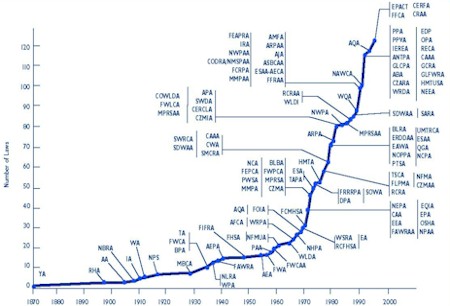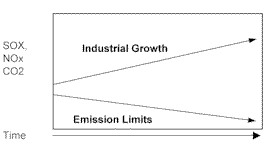|
||
| What
is Green Engineering | EPA's
GE Program | An Introduction
to GE | Risk Assessment Applied to Pollution Prevention |
|
|
|
|
Green engineering is the design, commercialization, and use of processes and products, which are feasible and economical while minimizing 1) generation of pollution at the source and 2) risk to human health and the environment. Green engineering embraces the concept that decisions to protect human health and the environment can have the greatest impact and cost effectiveness when applied early to the design and development phase of a process or product. Principles of Green Engineering*
*as developed by more than 65 engineers
and scientists at the Green Engineering: Defining the Principles
Conference, held in Sandestin, Florida in May of 2003. The preliminary
principles forged at this multidisciplinary conference are intended
for engineers to use as a guidance in the design or redesign of
products and processes within the constraints dictated by business,
government and society such as cost, safety, performance and environmental
impact. |
|
| EPA's Green Engineering Program |
|
The goal of the Green Engineering Program is to incorporate risk related concepts into chemical processes and products designed by academia and industry. This program targets 4 major sectors:
Considering Chemical Risks in Design EPA's Office of Pollution Prevention and Toxics (OPPT) utilizes various tools and methods to determine if the manufacture, processing, use, or disposal of chemical substances may present unreasonable risks to human health or the environment. OPPT also identifies opportunities to minimize chemical hazards and exposures to raw materials, products, and wastes by employing alternative technologies and environmentally benign chemicals. Current engineering approaches to pollution prevention appear to emphasize waste minimization rather than the direct impact on human health and the environment. Why EPA? By incorporating risk assessment tools as well as release and exposure models and methodologies into process design, EPA offers an unique approach to green engineering. The Green Engineering Program has pioneered the use of risk assessment tools beyond just screening chemicals; this program applies these tools to the following areas:
The integration of risk assessment and chemical engineering has already proven valuable in EPA's Premanufacture Notification (PMN) Program. Under the PMN Program, chemical engineers use engineering models as well as experience to estimate the releases and exposures from chemical processes. Risk assessment tools are then applied to gauge the health and environmental effects of more than 2,000 chemicals each year. These assessments are made with very little, if any existing data on the chemical. With the expertise gained from the PMN Program, EPA is uniquely qualified to incorporate a risk element into existing pollution prevention measures and the design of processes and products. EPA’s Green Engineering team is comprised of chemical engineers and industrial hygienists with diverse industrial and academic experiences. The team has more than 80 years of combined experience in industry, including the chemical processing, agriculture, and pulp and paper industries. Other EPA personnel involved in the program are experts in risk assessment, toxicology, industrial hygiene, green chemistry, environmental fate and transport, and economics. Academics also play a vital role in the development of the Green Engineering curriculum; primarily by authoring the Green Engineering textbook, reviewing materials, and providing supplemental information as well as input on program applicability to students. |
|
|
|
Green Engineering: On the Cutting Edge of Environmental Protection Every year, U.S. industry generates billions of tons of waste that creates potential risks to human health and the environment. Also, waste generation comes with a high price tag. Managing wastes costs hundreds of billions of dollars annually; and these costs are mushrooming as regulatory measures increase in numbers. The following graph (click to enlarge), which displays the increase in environmental regulations from 1870 to present, demonstrates this trend. Proliferation of Environmental Laws and Regulations |
|
|
|
| Although the number of regulations was on the rise in the mid 60's, the majority of the
regulations (75%) were passed after 1970 following the creation of the U.S. EPA. (See the environmental regulation summary table
in Chapter 3 of the Green Engineering textbook for information on major environmental regulations).
As industry continues to expand and permissible exposure limits continue to decrease, waste treatment and the associated risk are becoming less cost efficient and more difficult to handle. The figure below depicts the general trend observed over time of reduced emission limits in conjunction with increased industrial growth. |
|
|
|
| Over the past decade an emerging approach has helped to help
reverse this trend. The
33/50 Program targeted 17 priority chemicals over a 5-year period, where releases and transfers of the chemicals reported to TRI decreased 47%.
Engineers have used several strategies to minimize the impact of chemical processes on human health and the environment. By selecting chemicals that have low toxicity, potential hazards are eliminated and chemical releases are prevented, thereby reducing chemical exposures. Thus, environmentally conscious design reduces risks to ecosystems, workers, consumers, and the general population while generating cost savings to the manufacturer. |
|
|
|
|
Risk Assessment: The Concept Risk assessment considers the extent of harm a chemical and its uses pose to human health and the environment. Mathematically expressed it is a function of hazards and exposures. A hazard is anything that will produce an adverse effect on human health and the environment. Exposure is the quantitative or qualitative assessment of contact to the skin or orifices of the body by a chemical. Traditional pollution prevention techniques focus on reducing waste as much as possible however, risk assessment methods used in pollution prevention can help quantify the degree of environmental impact for individual chemicals. With this approach, engineers can intelligently design processes and products by focusing on the most beneficial methods to minimize risk. By applying risk assessment concepts to processes and products, the engineer can accomplish the following:
Risk Assessment Software Tools Risk assessment software tools are available to academia and industry through a Pollution Prevention Tools Suite, which includes a compilation of risk assessment tools as well as methods and models to assess releases and exposures in the workplace, used by EPA. Examples of software tools used for risk screening include hazards, determination, exposure, assessment, and fate estimation, as well as other commercially available risk assessment/pollution prevention tools. All of these tools can assist engineers in the prioritization, design, and selection of "greener" processes and products. |
![[logo] US EPA](https://webarchive.library.unt.edu/eot2008/20090508063401im_/http://www.epa.gov/epafiles/images/logo_epaseal.gif)

